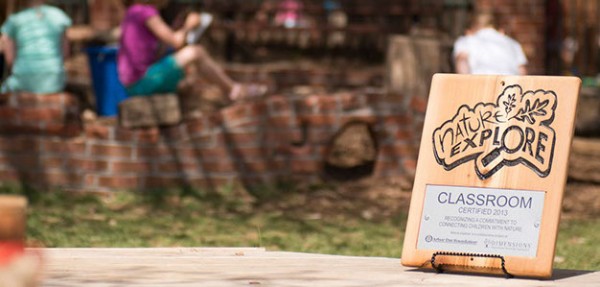
Our Nature Explore Classroom
Creating Dimensions’ Nature Explore Classroom –
A Collaborative Effort
Initial plans to develop an outdoor classroom began in 2001. Early collaborations included teachers and staff, consultants, an architectural firm, and local community agencies and businesses (e.g., the State Health Department, Spring Creek Prairie, Shadow Brook Farms, Nebraska Statewide Arboretum). Children also played a vital role in the collaboration.
In anticipation of the outdoor classroom project moving forward, the existing, small playground was removed. When construction of the new outdoor classroom began, we hit some roadblocks that stalled progress for almost 18 months. During these months, there was no designated outdoor space for children – as the program director recalled, “everything was a blank slate”. Teachers recognized that they had the opportunity to create what they believed would be a variety of meaningful gardening and nature activities, and field-test them. The best part was that they could “try anything” because there was nothing children could do to damage the space.
Having time to field-test activities was critical to the development of the outdoor classroom, gardens and greenhouse. Teachers experimented with many activities, even setting up separate stations that children could circulate among. Tree trunks became natural balance beams, teachers introduced water features and documented how children interacted with them, there was a station in the program director’s backyard where children could dig, plant things and build structures with natural materials. One of the biggest experiments was that a teacher arranged to have a dump truck of mulch deposited in a large, open area. Teachers contributed long willow branches, scavenged the neighborhood for tree trunks, and arranged for a large tree trunk to be delivered. Initially many of the teachers were “skeptical” and concerned that the area looked dangerous. Some said they would not take their children to this area. As it turned out, “children loved this area” and once teachers taught children how to cooperatively use the space there were no problems. As the mulch composted, children dug tunnels through it that they could crawl through. One of the things teachers discovered was that children “just love digging in the dirt”! This discovery led to the later creation of a dirt-digging area in our outdoor classroom.
Trees were especially important to children during this time. There was a line of fir trees along the edge of the space and teachers and children trimmed the bottoms slightly, so children could go underneath and feel the shelter of the trees, and climb up a ways, and look down, like birds, giving them the opportunity to “see things from multiple perspectives”. Teachers explained to children that they were not damaging the trees, only “giving them a haircut”.
Children created many of their learning experiences on their own. They initiated a “nature club” and created a club song with multiple verses (“we love our nature, our country’s nature green and brown”…”we salute our nature”… “we march to our nature, our country’s nature”…). Children created a pledge (“We pledge allegiance to the nature of the United States of America…). For months, when children went outdoors, they spontaneously ran to the trees, sang their song and recited their pledge.
During these eighteen months, teachers closely observed children. They documented the result of each field-tested activity. They paid attention to what children liked and did not like. They noted children’s use of space and materials at points in time. They involved children in the design process by asking children to design their own spaces. Children created interesting visual representations, models, even miniature gardens. Children’s designs communicated the need for more room than was originally planned for gardening space, and accentuated the importance of pathways through the gardens, so they could look closely at plants and flowers, and touch and smell them.
According to the program director, months of field-testing and close observation of children “netted real surprises”. “Things we (adults) thought would be wonderful weren’t. Things we were skeptical of, like the messy materials area, turned out to be the best idea”. As a result of months of field-testing, the plans for the outdoor classroom “changed dramatically”. Dimensions’ movement consultant and landscape architects became involved with children and teachers in re-designing the outdoor classroom and garden space. One community foundation noted children’s love for planting and thought it would be important to give children those kinds of experiences year-round, and agreed to fund a greenhouse.
As the outdoor classroom took shape, parents and community members who observed the design process saw the value of the space we were creating for children. Parents who worked for an architectural firm and an arboretum donated time, staff, and materials to create limestone and slate paths through the garden spaces. Parents who own Shadow Brook Farm, a local, family owned specialty vegetable farm, built the child-size tables and benches for the greenhouse and one facilitated small group activities in the greenhouse twice a month, including bringing baby goats and calves for children to enjoy. A local sculptor crafted an organic-shaped, low brick wall that serves as a boundary for the messy materials area. Kindergarten children helped him make the bricks, and put their hand and footprints in them.
As we re-designed the outdoor classroom space, we learned a lot. One of the most important principles we learned during the design phase was that outdoor spaces must be constructed intentionally to maximize children’s learning, just as indoor classrooms must be designed intentionally. As a result, we created separate areas in our outdoor classroom, including a gathering area where children make their plans, a 12′ x 20′ greenhouse, vegetable and perennial gardens, a climbing/crawling structure, a large L-shaped sand area, a spacious messy materials area, a large grassy open area for gross motor movement, and a music and movement area that has several handmade, wooden instruments. Transportable tables transform any space in the outdoor classroom into a “nature art area”. This work laid the foundation for creating the Nature Explore Outdoor Classroom guiding principles.
Click here to view our Certified Nature Explore Outdoor Classroom page.
